A WOLFISH SOLITUDE, painting by the author, 2025
I am in the process of slowly transferring and rewriting some essays I wrote on Wordpress about a decade ago. This piece was originally written in 2014 (before I had published any books). For a bit more context: my three children were aged between 10 and 14 at that time.
The word ”selfish’ has come up quite a few times in recent conversation with (admittedly female) friends. Women often face tough lessons when it comes to Self, because we are socially conditioned, from a very young age, to be pro-social, prioritize relationships and “put others first”. In my own case, I know that this goes back, not only to my own personal childhood, but it also involves deeply-rooted intergenerational patterns, established long before I was born.
In my own life things have changed in recent years (and I will write more about that in the closing paragraphs) but for many decades I struggled with the following question: how far do I go in denying or even violating my own needs, feelings, priorities to be there for others? When those “others” are one’s own dearly loved children, as is the case for most mothers, the picture isn’t always clear!
Selflessness is commonly seen as a virtue, but is it?
I stopped watching TV when our first son was born (as I’d much rather paint, write or make music). So I am about 25 years behind in terms of what TV is serving up! However, I do remember watching a documentary about “Child Carers” three decades ago. It followed the lives of young children (8, 9, 10, 11 years old) who were care providers for sick or disabled parents. They would get up extra early, make Mum or Dad breakfast and make sure they had taken their medication, go to school, come home again (deal with another round of medical checks and medication) and then cook dinner for the family. This TV program sang the praises of those “selfless child heroes” but in truth I was appalled. Being a “parentified child” is a fate I would not wish upon any child. These children were essentially asked to sacrifice their childhood to play this adult role - and no child should have to do that.
It is the responsibility of social services, to make sure essential care tasks are performed. That week I happened to talk to a woman who’d watched the same program. I still remember her reaction: “Praising them and calling them “heroes” really means telling them them to keeping going and do more, more, MORE! It is a crime against children!” I agree. Sure, parents can fall ill briefly and an unforeseen crisis or circumstances can occur. Children and young teens can step up for a few days, or maybe even a few weeks (and definitely learn some things along the way). But it should never be a way of life to carry this burden, and this expectation from the adults around them, year after year, AFTER YEAR. Just think of the energetic patterns and choices this sets in motion for the rest their lives. NO!!
It is very convenient for other people when our default setting is to act selflessly, but there is a serious risk of losing our own sense of self in the process. And what does that mean: loosing our sense of self? To me that means floating in an ocean of other people’s demands and emotions like a rudderless boat, without being anchored or tethered, not being ‘at the helm’ of our own lives and having agency over our own time, energy and life choices.
This week [writing in 2014] it suddenly hit me hard that I can not think of many positive words that have the word ‘self’ in them, only “SELF CARE”. For me that words carries positive connotations.
However, the same is not true for:
SELFISH, SELF-CENTERED, SELF-INVOLVED, (EGOISTIC), SELF-SEEKING, SELF-OBSESSED…
COMING OUT OF THE CLOSET, painting by the author, 2025
Eleven years later [writing this paragraph in October 2025)] I observe that the word Narcissism has “exploded” onto the scene: there is now an abundance of books, YouTube videos and social media content about narcissism. There are also many Influencers who have made exposing narcissism, and providing online advice on surviving it, their brand. So far I have written three essays about spiritual narcissism here on Substack:
#1 SPIRITUAL NARCISSISM (And other forms of spiritual bypassing)
#2 SPIRITUAL NARCISSISM Part 2 (More dynamics flagged by readers)
#3 DOES WESTERN CULTURE ACTIVELY PROMOTE NARCISSISM? (Stretching social norms at our peril)
I decided to run a word search and found one more positive phrase “SELF-HEAL”! (This is a key word in my shamanic practice: activating the innate ability to heal in clients. In my third non-fiction book, Medicine of the Imagination, I call this the Inner Healer and provide exercises for doing this).
Technically speaking, the polar opposite of the word “selfishness” is supposed to be altruism (I guess) but for me the opposite of selfishness is: being self-asserted, grounded, tethered to spirit, able to set (and reinforce) healthy personal boundaries.
My childhood experiences (which included closely observing my mother’s life choices) have taught me that acting from a core setting of ‘being out of touch with Self’ doesn’t work, because decisions or commitments don’t feel right and anger comes into the picture. (Sooner or later I got angry with myself - because of the lack of agency and the loss of precious time and energy. That anger eventually spilled over into my relationships with others in the form of resentment).
Western culture sends us mixed messages when it comes to “selfishness’”. I had a Roman Catholic upbringing where self sacrifice was seen as a virtue and therefore promoted at every opportunity. Martyrs are big in the Roman Catholic tradition and sometimes I still have to deal with an archetype I (have come to) call “The Inner Martyr”! I cannot wipe it out but I can have better-informed dialogues with it!
Selfishness was viewed in the Western Christian tradition as a central vice – as standing at the roots of the Seven Deadly Sins in the form of pride. SOURCE
Most modern psychotherapists would say that a ‘healthy sense of self’ is at the very core of being a vital and productive member of society. That sense of self does not refer to the pursuit of egotistic desires at the expense of others, but it refers to a calm inner coherence. Knowing who we are and knowing what our unique strengths and weaknesses are. Not being trapped in responding to the never-ending tilting and shifting of our world with 24/7 reactivity. It means feeling free to choose our course of action, rather than being manipulated or triggered into reacting on auto-pilot. Perhaps most of all it involves feeling free to say “no”, without experiencing any guilt at all (to other people such residual guilt is sensed as “space for another round of negotiation”!)
(Writing in 2014) As a shamanic practitioner and teacher I feel that a healthy connection to Spirit as well as a healthy sense of self are required for accomplishing what we have come to do here on Earth, our unique soul task.
To me our Self is the spiritual vessel, or container, that allows us to be here. Just as my body is the physical vessel that allows me to actively participate in life on earth. However, ultimately I am ‘not a body with spirit’, I am pure spirit, or a soul, temporarily residing in a human body.
“Self” is the construct that allows me to perceive myself as separate from others and from All That Is, so I can do the maximum amount of both working and learning, here on our beautiful planet. However, spiritually speaking I also know that part of me always yearns for unity consciousness (returning to Oneness with the Divine). Mystical experiences offer brief glimpses of this. My ultimate take on ‘selfishness’ is that it is through experiencing “Self” that I learn and understand (both myself and others) but the paradox is that I must also work towards relinquishing that sense of Self one day. I must learn to tell when I am acting from Ego and when I am truly acting in the best interests of Self, and the learning journey of Self.
Many spiritual traditions tell us that in the moment of death Ego dies, but our Spirit (or Soul) continues the great spiritual journey home to our Divine Origin or Creator (or Source) I do not call that state, of returning to unity consciousness with a force higher or greater than myself, ‘selflessness’ or ‘altruism’, I call that ‘transcending Self’.
Post Script in 2025
Writing these closing paragraphs 11 years later (in 2025) I can add that major shifts have occurred, in my own life, since 2014. Some within myself and and some on the outside. My sons are all in their 20s now and capable of living independently. This means I can spend more time in Sweden, living my best life as a Forest Witch and enjoy long stretches of solitude.
My elderly mother died in 2022 and with her died a long-standing obligation to make (very re-traumatizing) regular visits to the Netherlands. The world has changed too. We have all lived through a Pandemic and here in the UK we have also lived through Brexit. Both events only appear to have added to the polarization of society. Narcissism is flourishing and so is advice on the Internet for surviving narcissists and bringing oneself to emotional safety.
DEEP DREAMING, painting by the author, 2025
For about 15 years now, people have called me a Wise Woman or an Elder, and I have always protested and swept this off the table: I am too young, I am not there yet, I still have children living at home etc. (Plenty of excuses!) Suddenly the matter is much clearer: our world is moving through times of danger and upheaval.
My (AND YOUR) unique Hag Medicine, Elder Medicine or Soul Medicine, is needed NOW, not maybe twenty years from now. This is a time of all hands on deck!
As a young Elder and Pregnant Hag I have dropped the notion that other people are entitled to my time and energy just because they ask for it (my husband, children and close friends are obviously excepted!) I have also dropped all notions (which I harbored in my early days as a shamanic teacher) of “changing the world” but I know, from feedback received, that my work has made a difference in the lives of some people (and that is plenty, I am grateful).
Let me close by reproducing words from a previous essay (which was a watershed essay in my own life), WHAT SHE SHEDS:
I just heard on a podcast that every part of the human body “sheds” (sloughs of cells and renews itself) except the teeth. Of course animals shed too: snakes shed their skin, birds drop feathers, mammals moult (hair and fur especially) and even beluga whales shed old yellow skin to remain snow white!
Some birds even become flightless during their annual wing moult, meaning that they need to seek refuge in a protective habitat, to allow this process to runs its course. As an avid feather-collector, I always feel that women can learn so much from birds. Birds take us back to the Neolithic Bird Goddess that the Lithuanian archaeologist and anthropologist Marija Gimbutas wrote so passionately about! And all the goddess figurines from Old Europe that she excavated. I have already learned to hibernate in a snow den, like a bear. Now I need to learn how to moult with grace, and build time for that into my annual cycle or schedule.
HIBERNATION, painting by the author, 2025
After decades of prioritizing others, I now know deeply and unequivocally that self-care and regular cave time are my personal keys to being there for others (and continuing to teach and see clients). After years of speaking, Silence has become more important. As has the compassionate witnessing of All That Seeks Attention (or balancing) and needs to be lovingly cradled for a while. “I see you!” And it is only in places of Profound Silence that the non-human voices and non-dominant voices become louder and clearer.
I try (but sometimes fail) to get out at least one essay a week (sometimes more), due to travel, international teaching commitments and family care responsibilities (our family lives with Alzheimer’s and I have written several posts about that). If you would like to see regular posts about about Nordic spirituality and my life as a Forest Witch (and of course short videos of all the wildlife here!), please follow me on Instagram or Facebook, thank you!
As my audience here grows daily I need to add the following statement: ©I own the copyright to all my own words and images, as they appear here on Substack (or anywhere else). You can only reproduce this material (full or in part) elsewhere, if you give me full credit as the author and or artist. Most of you already knew this! Thank you!
Imelda Almqvist, London, UK
BIO FOR IMELDA ALMQVIST
Imelda Almqvist is an international teacher of Sacred Art and Seiðr/Old Norse Traditions (the ancestral wisdom teachings of Northern Europe). So far she has written four non-fiction books and two picture books for children. Natural Born Shamans: A Spiritual Toolkit for Life (Using shamanism creatively with young people of all ages) in 2016, Sacred Art: A Hollow Bone for Spirit (Where Art Meets Shamanism) in 2019, Medicine of the Imagination - Dwelling in Possibility (an impassioned plea for fearless imagination) in 2020 and North Sea Water In My Veins (The Pre-Christian spirituality of the Low Countries) was published in June 2022.
The Green Bear is a series of picture book for children, aged 3 – 8 years. The stories and vibrant artwork, set in Scandinavia, invite children to explore enchanting parallel worlds and to keep their sense of magic alive as they grow up.
Imelda appears in a TV program, titled Ice Age Shaman, made for the Smithsonian Museum, in the series Mystic Britain, talking about Mesolithic arctic deer shamanism.
Imelda’s eagerly awaited book about the runes (the title is Portals, Patterns and Pathways, a Handbook for Rune Magicians, Star Gazers and Myth Makers) will be published by Collective Ink on 26 May 2026). She is currently working on a book about Inuit deities and mythology.
Imelda prefers being contacted by email. She only rarely checks (or responds) to DM’s on social media platforms.
Please note that Imelda’s on-line school called Pregnant Hag Teachings went off-line on 3 September 2025, due to a quadruple raise in fees imposed by the hosting platform. PUBLIC ANNOUNCEMENT AND FULL EXPLANATION
Website:
http://www.shaman-healer-painter.co.uk/
YouTube Channel: youtube.com/user/imeldaalmqvist
Facebook: https://www.facebook.com/imelda.almqvist/
Instagram: https://www.instagram.com/almqvistimelda/


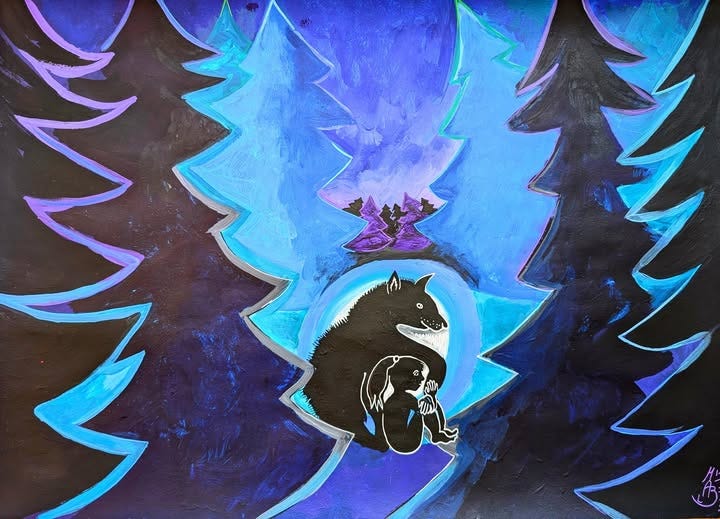
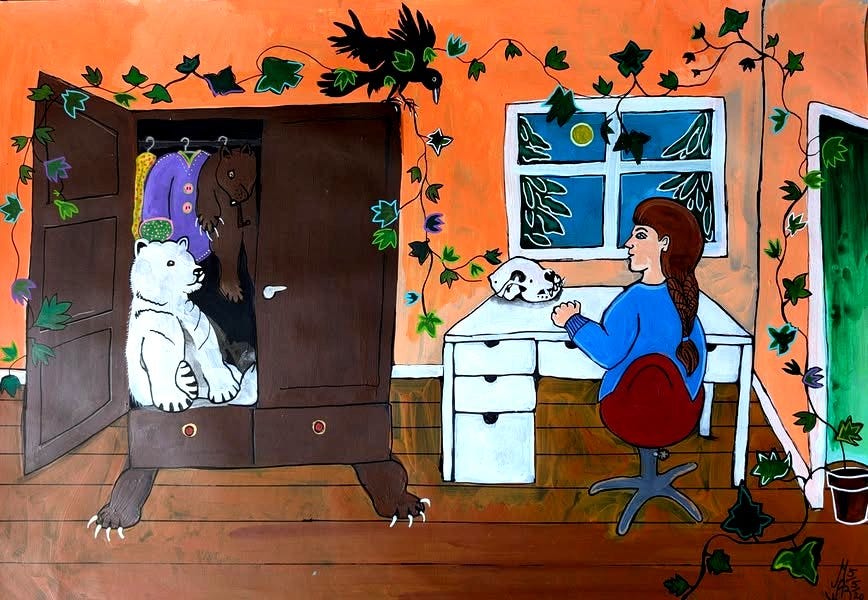

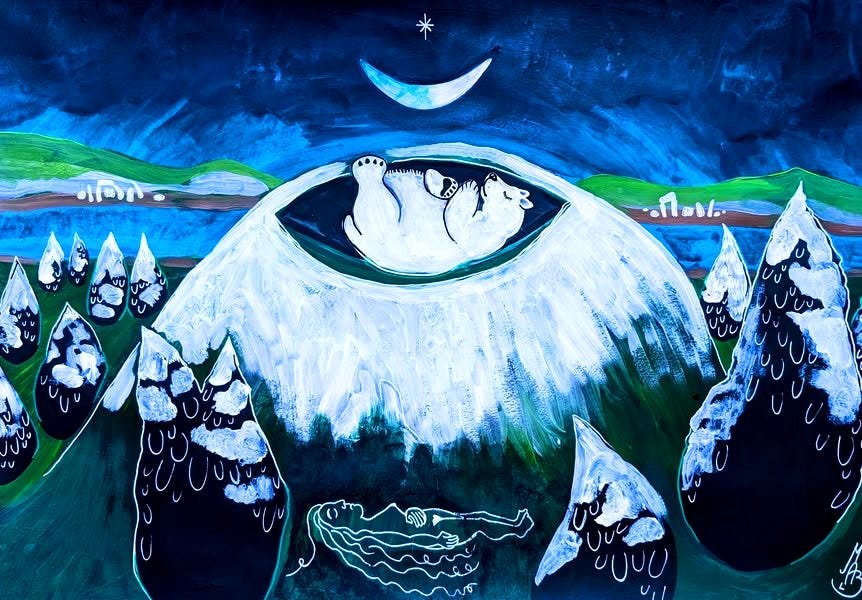
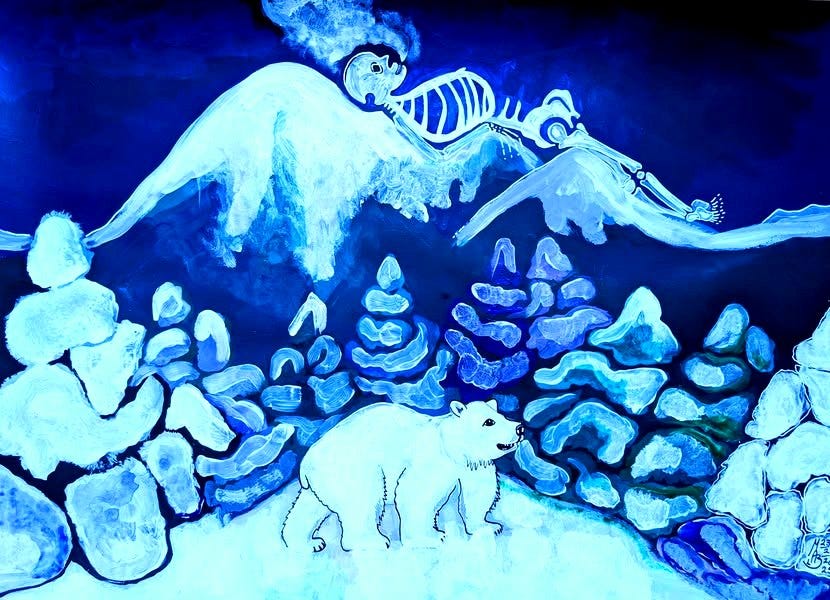
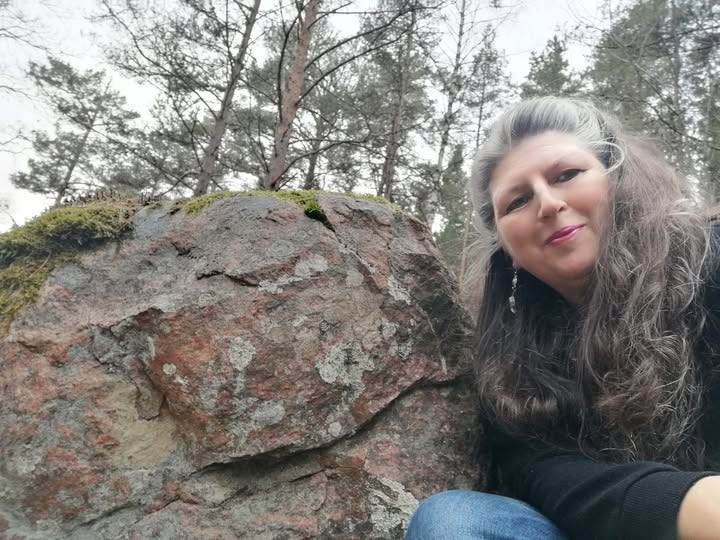
Growing up in a family where alcohol abuse was "the large pink elephant in the living room" no one spoke of, I have learned about codependency the hard way. That is closely connected to the conflicts of service/selfishness and putting own needs first and meeting the needs of others. It depends really on what level of the complex system you position yourself in, when you look at this issue. Different aspects give different point of views. I was indeed startled the other day when I heard in meditation "Do you want to take responsibility for humankind, or do you want to be free of you physical pain?" And suddenly I realized I was acting in a codependent way with the misuse of power by humans in the world. I felt guilty for other humans deeds against our home in the Universe, the Earth, and I felt guilty for world leaders misusing their powers and creating hell on Earth for other human beeings. I was angry, the same way I was at my Dad, when he could not stop drinking. At the same time I covered up for him, defending him, helping to keep the pink elephant in the living room invisible. I am not at the moment 100 % sure in what ways I take responsibility the wrong way today, for the misuse of power by humans in the world, but I can feel in my bones that I do! It feels like I have to make a change, like when I had to choose in between keeping my Dad alive, or myself.
This story is to be continued some day. I am not at all ready with it.
This is a subject that I have often thought about. In Buddhism when contemplating compassion for all sentient beings, we are encouraged to remember that we are one of those sentient beings. It takes tremendous courage to think and act of ones own needs! I think it’s also tied into the ‘doing is succeeding’ culture we live in. It doesn’t exist in all cultures, which suggests that there are multiple levels tied to these feelings/habits.